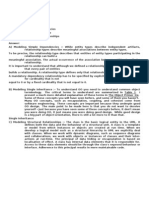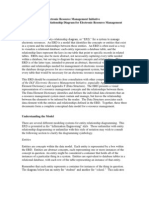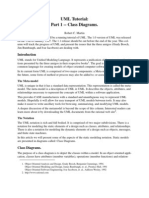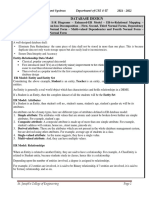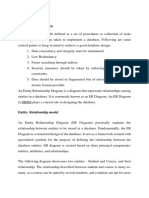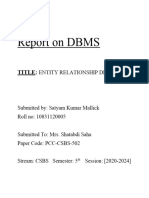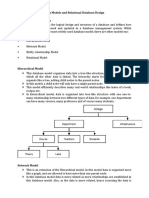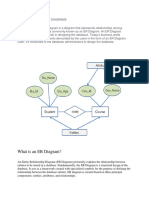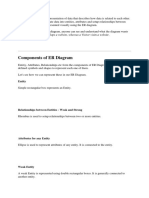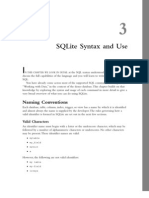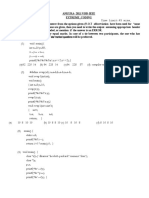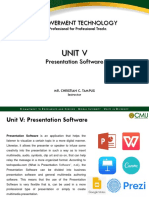UML Guide v2
UML Guide v2
Uploaded by
sairam0029Copyright:
Available Formats
UML Guide v2
UML Guide v2
Uploaded by
sairam0029Copyright
Available Formats
Share this document
Did you find this document useful?
Is this content inappropriate?
Copyright:
Available Formats
UML Guide v2
UML Guide v2
Uploaded by
sairam0029Copyright:
Available Formats
UML Guide v2.
1
Author: Rajinder Yadav Date: Oct 7, 2007
Dependency In UML modeling as in life, UML elements can be related in many ways. Relationships are represented by a connecting line between two UML elements. The relationship can be directed, stating the form of communication, control or awareness is one way. A directed relationship will be shown with one end having an arrow. Usually this type of relationship is a "uses"relationship and is called a dependency.
Diagram 1 - Dependency
Usually the "using" end in a relationship will be aware of the other end it's using, but it's not always the case the "used" end is aware who is using it. Think of an application that needs to log errors to a file, the logger will not know who is sending it data, all it is told is what data to write to the log file. Association For relationships that are bidirectional, the common way to draw the relationship is with a solid line connecting the two UML elements without arrows. This type of relationship is called an association. You can still choose to draw two directed lines denoting each type of relationship, but too many line can clutter up diagrams unnecessarily.
Diagram 2 - Association
The diagrams above show that both UML elements are aware of each other. The document is responsible for the creation of the view, but it is the view that "uses" the document to get data to be displayed. The document doesn't control the view, it is the view that pulls the data from the document. From time to time the document may send Refresh or Update notification to the view when data is changed. Essentially both diagrams show the same thing, just take care to note the placement of the labels on the associations. Aggregation There are times when you need to show a whole/part relationship, where one thing contains zero or more other things. Now you might be wondering how something can contain "zero" of something? This really should be understood to mean that the containing thing doesn't necessarily need the presence of the contained things in order to exist. The following diagram displays this clearly. The containing UML element will have a hollow shaped diamond on the connecting lines. A school holds both zero or more teachers and students, but the school, students and teacher can exist on their own as well. This is a weakly-coupled relationship and is called an aggregation.
Diagram 3 - Aggregation
Composition There is a special whole/part relationship where one thing contains one or more things. This is a more stronger relationship where one needs the other in order to exist. Here are two diagrams that display composite relationships. The following diagram displays this clearly. The containing UML element will have a solid shaped diamond on the connecting lines. In the first diagram, both the human and heart need each other in order to exist. In the second diagram, a car cannot exist without wheels, an engine and doors, yet the doors, engine and wheels that make up the car can exist by themselves.
Diagram 4 - Composition
Note: An aggregation and composition is also known as a, "has-a" relationship, such as a human "has-a" heart. Multiplicity In a whole/part diagram, there needs to be a way to convey a count of the contained things in a short-form. This is shown as labelling each end of the relationship with a number, or with an "*" asterisk for a value of "zero or more". In the composition diagram (Dia.4), a human has only one heart, read another way, a heart can only belong to one human. In the association diagram(Dia.3), we see that zero or more teachers belong to a school. Finally, we may also have many to many relationship, take for instance students and classes. A student can be enrolled in zero or more classes, while a class can teach zero or more students, this type or association would be labeled as, "*..*" along the connecting line. Mul Description 1 One and only one. 0..1 Zero or one. 0..* Zero or more. * Zero or more. 1..* 1 or more. I..J From I to J (integer values) *..* Many to many.
Table 1 - Association Multiplicity
Previous
Next
You might also like
- Top 50 Business Analyst Interview QuestionsDocument18 pagesTop 50 Business Analyst Interview QuestionsA'del Jumma100% (1)
- Class Diagram HandoutsDocument9 pagesClass Diagram HandoutsA ANo ratings yet
- UML Association Vs Aggregation Vs CompositionDocument4 pagesUML Association Vs Aggregation Vs CompositionGerardo Castro MtzNo ratings yet
- MC0069 - System Analysis & Assignment Set - 1Document14 pagesMC0069 - System Analysis & Assignment Set - 1Nakul VegadNo ratings yet
- Data Models in DBMSDocument12 pagesData Models in DBMSnarikitsNo ratings yet
- Report of The DLF Electronic Resource Management Initiative Appendix D: Entity Relationship Diagram For Electronic Resource ManagementDocument13 pagesReport of The DLF Electronic Resource Management Initiative Appendix D: Entity Relationship Diagram For Electronic Resource ManagementDhirBagulNo ratings yet
- UML NoteDocument7 pagesUML NoteRajashreeRajNo ratings yet
- CS8492 - DBMS - Unit 2Document18 pagesCS8492 - DBMS - Unit 2Bharathi AishuNo ratings yet
- Experiment No 5: Aim: Develop UML Case and Class Diagram For ProjectDocument7 pagesExperiment No 5: Aim: Develop UML Case and Class Diagram For ProjectTanmayNo ratings yet
- (Ebook - PDF - UML) UML Tutorial - Class DiagramsDocument7 pages(Ebook - PDF - UML) UML Tutorial - Class DiagramsNguyễn Quang Vinh100% (1)
- Class DiagramDocument20 pagesClass DiagramFranck divinfranckNo ratings yet
- Class diagramDocument23 pagesClass diagramsaifijamil00No ratings yet
- CS8492 - DBMS - Unit 2Document18 pagesCS8492 - DBMS - Unit 2alexb072002No ratings yet
- Unit Ii Database DesignDocument18 pagesUnit Ii Database DesignHarish SNo ratings yet
- Unit-2 (Part-A) Notes of OOP (KOE-064) Subject by Updesh Jaiswal Given To Students at AKGECDocument8 pagesUnit-2 (Part-A) Notes of OOP (KOE-064) Subject by Updesh Jaiswal Given To Students at AKGECviku9267No ratings yet
- Class Diagram ExamplesDocument7 pagesClass Diagram ExamplesGokul PrasathNo ratings yet
- Data Models in DBMS Unit 2Document24 pagesData Models in DBMS Unit 2Shubham SharmaNo ratings yet
- PDF Class Diagram UnDocument35 pagesPDF Class Diagram UnParamjeet SinghNo ratings yet
- UNIT 02 RdbmsDocument26 pagesUNIT 02 Rdbmssujankn2302No ratings yet
- Report of The DLF Electronic Resource Management Initiative Appendix D: Entity Relationship Diagram For Electronic Resource ManagementDocument12 pagesReport of The DLF Electronic Resource Management Initiative Appendix D: Entity Relationship Diagram For Electronic Resource ManagementWan Lutfy AsriNo ratings yet
- E R DiagramDocument6 pagesE R DiagramLloyd PiscaderoNo ratings yet
- Report of The DLF Electronic Resource Management Initiative Appendix D: Entity Relationship Diagram For Electronic Resource ManagementDocument12 pagesReport of The DLF Electronic Resource Management Initiative Appendix D: Entity Relationship Diagram For Electronic Resource Management1NessaNo ratings yet
- Week6 7 Cce104lDocument10 pagesWeek6 7 Cce104lVan ClarinNo ratings yet
- ER Diagram RepresentationDocument9 pagesER Diagram RepresentationWhite AntNo ratings yet
- C++ Group 1 AssignmentDocument7 pagesC++ Group 1 AssignmentRufaro Nothando MhondeNo ratings yet
- Entity and Entity Set ManualsDocument22 pagesEntity and Entity Set Manualsaimlds.pythonNo ratings yet
- Benefits of Class DiagramDocument17 pagesBenefits of Class DiagramAadam Yuusuf100% (1)
- TCS Aspire RDBMS - 2Document23 pagesTCS Aspire RDBMS - 2shri harsha0% (2)
- Data ModelDocument9 pagesData ModelsuvadarshiniswainNo ratings yet
- Anish GuptaDocument14 pagesAnish GuptaSatyam MallickNo ratings yet
- ch-5 RelationshipsDocument25 pagesch-5 RelationshipsbhargaviNo ratings yet
- Association Vs Aggregation Vs CompositionDocument6 pagesAssociation Vs Aggregation Vs Compositionsharan kommiNo ratings yet
- Association, Aggregation, Composition, Abstraction, Generalization, Realization, DependencyDocument16 pagesAssociation, Aggregation, Composition, Abstraction, Generalization, Realization, Dependencytarunkusum50% (2)
- Dbms 2Document50 pagesDbms 2VedantGonnadeNo ratings yet
- 5.1 Data Models - ER ModelDocument9 pages5.1 Data Models - ER Model2002746.it.cecNo ratings yet
- week8-lecture16-E-R DiagramDocument5 pagesweek8-lecture16-E-R DiagramDevelopers torchNo ratings yet
- DBMS - Data Models and Relational Database Design NotesDocument48 pagesDBMS - Data Models and Relational Database Design NotesKomal Ramteke100% (1)
- CS8492 DBMS Unit 2 PDFDocument18 pagesCS8492 DBMS Unit 2 PDFMani Appu100% (1)
- UML OdtDocument6 pagesUML Odtcris_mbNo ratings yet
- Unit IIDocument46 pagesUnit IIomgunjal85No ratings yet
- Entity Relationship DiagramsDocument10 pagesEntity Relationship DiagramsnyandaruaeightNo ratings yet
- Lab - 2 Class Diagram: TheoryDocument10 pagesLab - 2 Class Diagram: TheoryAbhiyushNo ratings yet
- What Is A UML Diagram? What Is Meant by UML?Document18 pagesWhat Is A UML Diagram? What Is Meant by UML?siddhant kudesiaNo ratings yet
- 1.6-Types of UML DiagramsDocument8 pages1.6-Types of UML DiagramsUmar FarooqNo ratings yet
- Task 1Document9 pagesTask 1divijareddy0502No ratings yet
- UML Diagrams 1. Use Case DiagramsDocument20 pagesUML Diagrams 1. Use Case Diagramsfriend4spNo ratings yet
- Components of ER Diagram: EntityDocument5 pagesComponents of ER Diagram: EntityAyan SiddiquiNo ratings yet
- A Primer On Object Role Modeling: Stanley D. Blum, Museum of Vertebrate Zoology University of California, BerkeleyDocument8 pagesA Primer On Object Role Modeling: Stanley D. Blum, Museum of Vertebrate Zoology University of California, Berkeleyalynutzza90No ratings yet
- SS2 Note Data ProcessingDocument17 pagesSS2 Note Data ProcessingPeters Ebuka SundayNo ratings yet
- Lab 9Document6 pagesLab 9Syeda NimrahNo ratings yet
- E-R Diagram: ER-Diagram Is A Visual Representation of Data That Describes How Data Is Related To Each OtherDocument12 pagesE-R Diagram: ER-Diagram Is A Visual Representation of Data That Describes How Data Is Related To Each OthersubhamohanNo ratings yet
- History of ER DiagramsDocument7 pagesHistory of ER DiagramsRajesh Insb100% (1)
- 50 Useful Excel Functions: Excel Essentials, #3From Everand50 Useful Excel Functions: Excel Essentials, #3Rating: 5 out of 5 stars5/5 (5)
- Excel Formulas and Functions 2020: Excel Academy, #1From EverandExcel Formulas and Functions 2020: Excel Academy, #1Rating: 3.5 out of 5 stars3.5/5 (7)
- Vision (Small Project)Document6 pagesVision (Small Project)Luis Andre LoyolaNo ratings yet
- Sqlite Syntax and Use: Naming ConventionsDocument30 pagesSqlite Syntax and Use: Naming ConventionsKevin NguyenNo ratings yet
- C Programs PDFDocument16 pagesC Programs PDFNita kumalNo ratings yet
- Data ModellingDocument48 pagesData ModellingAbdullah Safar Alghamdi100% (2)
- Detect SQL Injection Wordpress Plugin Using Regex: Submit By: Suncsr (Sun Cyber Security Research)Document4 pagesDetect SQL Injection Wordpress Plugin Using Regex: Submit By: Suncsr (Sun Cyber Security Research)haxiwig567No ratings yet
- Usage GuideDocument6 pagesUsage GuidearistidezzNo ratings yet
- Cross-Platform Support For Rapid Development of Mobile Acoustic Sensing ApplicationsDocument13 pagesCross-Platform Support For Rapid Development of Mobile Acoustic Sensing ApplicationsJexiaNo ratings yet
- Assignment No: 2 Object Oriented ProgrammingDocument51 pagesAssignment No: 2 Object Oriented ProgrammingHasnain AliNo ratings yet
- aSMSC APIDocument29 pagesaSMSC APIKashif AnjumNo ratings yet
- Extreme Coding Ankura-2011 Nisb - IeeeDocument7 pagesExtreme Coding Ankura-2011 Nisb - IeeeGautam SinghNo ratings yet
- Test Automation Using Selenium Webdriver With Java: Navneesh GargDocument44 pagesTest Automation Using Selenium Webdriver With Java: Navneesh GargAnand DhanaNo ratings yet
- UntitledDocument71 pagesUntitledAhmad alfiqhy AryNo ratings yet
- Using and Abusing Container MetadataDocument44 pagesUsing and Abusing Container MetadataIvan MladenovicNo ratings yet
- Stacks and QueuesDocument29 pagesStacks and QueuesRajat SharmaNo ratings yet
- SCWCD QuestionsDocument18 pagesSCWCD QuestionsRitesh JhaNo ratings yet
- Lab - Batch Data Ingestion With DMS - Instructor SetupDocument16 pagesLab - Batch Data Ingestion With DMS - Instructor SetupJob Llanos MontaldoNo ratings yet
- Objc - App Archirecture - IOs Application Patterns in Swift (EnglishOnlineClub - Com)Document226 pagesObjc - App Archirecture - IOs Application Patterns in Swift (EnglishOnlineClub - Com)duylinhitNo ratings yet
- 3 Web Browsers For The Linux Command LineDocument6 pages3 Web Browsers For The Linux Command LineDr. Gerard J. RemillardNo ratings yet
- Students Will Able To Understand:: Dr. Naseer Ahmed Sajid Email Id: Whatsapp# 0346-5100010Document31 pagesStudents Will Able To Understand:: Dr. Naseer Ahmed Sajid Email Id: Whatsapp# 0346-5100010Muqaddas ZulfiqarNo ratings yet
- String Functions and File ProcessingDocument19 pagesString Functions and File Processingdomm prozNo ratings yet
- Presentation - SCCM - Advance - Day 1Document39 pagesPresentation - SCCM - Advance - Day 1Nitin PednekarNo ratings yet
- Empowerment Technology: Unit VDocument11 pagesEmpowerment Technology: Unit VCYREL JAY ROSALITANo ratings yet
- Sqlcommand Signature: ConstructorsDocument5 pagesSqlcommand Signature: ConstructorsmanigandanNo ratings yet
- RDBMS Unit-2 NotesDocument16 pagesRDBMS Unit-2 NotesAnirudh KumarNo ratings yet
- Quiz On c2Document6 pagesQuiz On c2CherryNo ratings yet
- Fazer BodDocument30 pagesFazer BodAlcatrazz Albion OnlineNo ratings yet
- Dialog Based ApplicationsDocument9 pagesDialog Based ApplicationssonibirenNo ratings yet
- openSAP s4h14 Week 2 All SlidesDocument95 pagesopenSAP s4h14 Week 2 All SlidesvenkateshNo ratings yet
- Student Evaluation SystemDocument33 pagesStudent Evaluation SystemAbhinav Vishwa67% (3)




